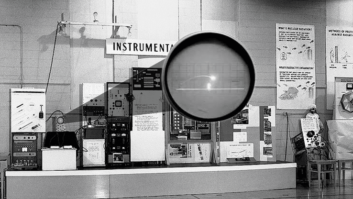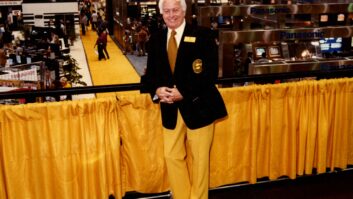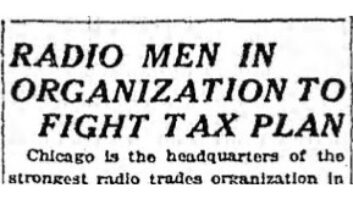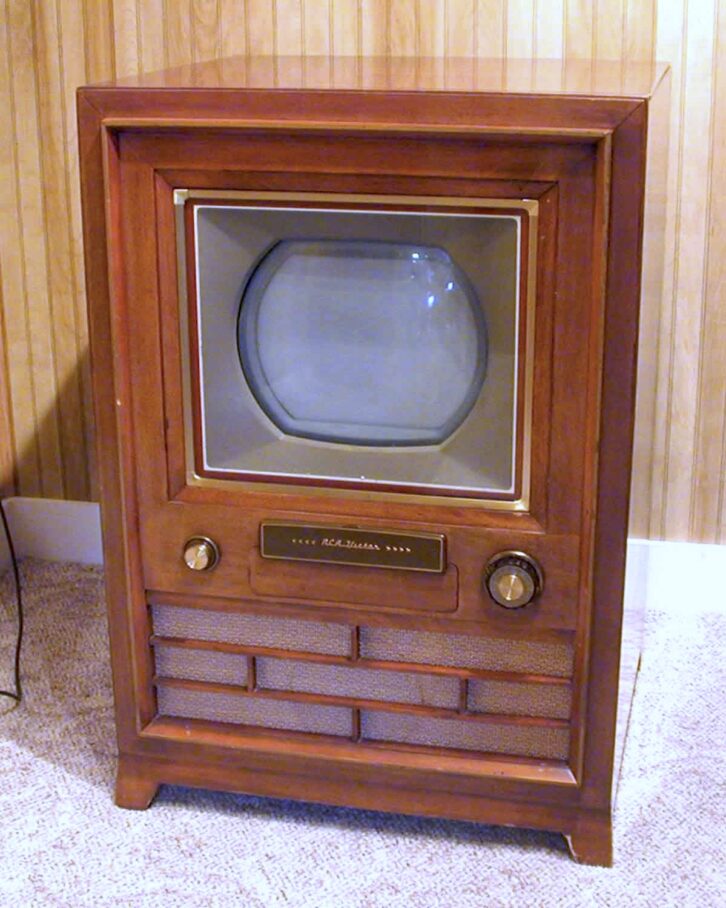
This year marks the 100th anniversary of the founding of the CTA (Consumer Technology Association), which started out as the RMA (Radio Manufacturers Association). This is the third in a series of essays exploring and celebrating CTA’s and our industry’s first century of invention, innovation, and entrepreneurship, assembled from varying technology historical research and writings I have done over the course of 20-plus years, including from an annually updated industry history for CTA’s now-defunct Digital America, 20-plus years of CTA Hall of Fame inductee biographies, and numerous tech history articles for a variety of publications over the years.
Read Part 1: Founding here, and Part 2: David Sarnoff here.
It is an unfortunate fact that war is a primary generator of new technologies. Just as the development of radio was juiced by its military need during World War I, World War II produced numerous technological breakthroughs including atomic energy, which in turn spurred the development of the computer, radar, lasers, plastics, microwaves (discovered by Marconi in 1932), and satellite communications.
But there was one less known breakthrough whose unlikeliness is equaled only by its continuing integral role in our modern wireless society. We’ll get to that fascinating story in just a second.
Technologically and societally speaking, the 1950s was dominated by the rapid rise of television. In 1947, only 250,000 TV sets were in use, but that small installed base didn’t stop John Winegard from developing the soon-to-be ubiquitous “yagi” rooftop TV antenna in his Burlington, Iowa, basement. In 1950, only 9% of U.S. households contained a TV. But by the end of 1954, sales of television sets surpassed sales of radios. By 1955, U.S. TV household penetration leaped to 64.5%, by 1960, it reached 87.1%.
Even RMA surrendered to the new technology and readjusted to the post-war electronics boom. In 1950, RMA changed its name to RTMA – the Radio-Television Manufacturers Association, then, in June 1953, changed it again to RETMA, the Radio-Electronics Television Manufacturers Association. In 1951, the organization hired its first full-time paid president, RCA VP Greg McDaniel.
Color TV
Early TV was monochrome, aka black & white, but both CBS and NBC were experimenting with competing color TV systems. The CBS color system was mechanical, based on the Nipkow Wheel, and developed by Hungarian refugee physicist Peter Goldmark, who would later invent the 33 rpm long-playing album, while RCA presented an electronic system based on the NTSC monochrome standard.
On October 11, 1950, the FCC initially approved CBS’ system. Except, not only did the CBS color standard require an ungainly color converter wheel, but it was also incompatible with the existing NTSC standard. To overcome this incompatibility, the FCC required TV makers to produce sets capable of receiving both black & white and non-compatible color signals, a stipulation TV makers understandably loathed. RCA, which also owned NBC, filed suit but, on May 28, 1951, the U.S. Supreme Court upheld the FCC’s decision.
The NTSC continued the fight, supported by Sarnoff. Finally, on December 17, 1953, the FCC approved the all-electronic NTSC color system proposed by RCA. This analog color TV standard stood until June 12, 2009, when analog TV broadcasting ended in the U.S., replaced by the digital standard, ATSC – which the David Sarnoff Research Center helped develop.
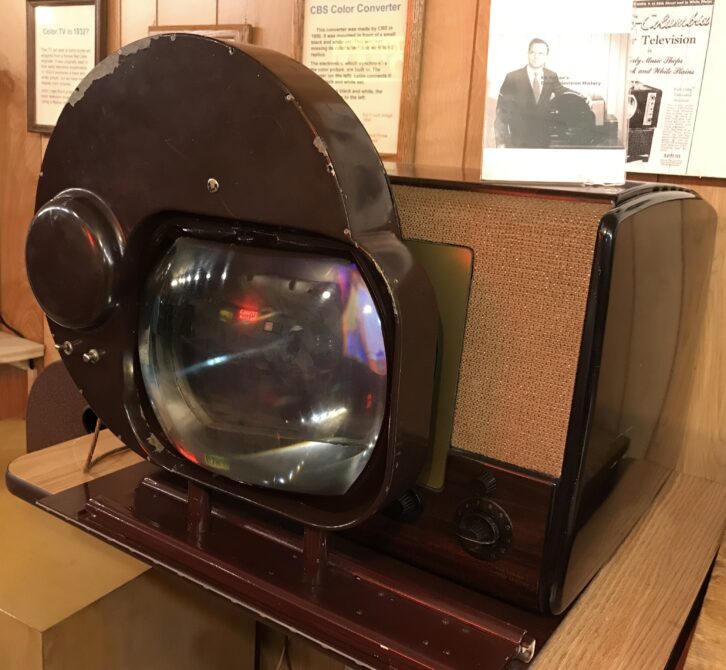
On December 30, 1953, Admiral became the first TV maker to sell a color set at retail, its C1617A priced at a massive $1,175 ($13,700 in 2024 dollars) when U.S. average household income was a mere $4,200, and RCA shipped 200 prototype 15-inch Model 5 sets to its top dealers around the country for viewing parties of the upcoming New Year’s Day Rose Bowl Parade, which NBC was broadcasting in living color, the first nationwide color broadcast. RCA’s Model 5 morphed into its $1,000 CT-100 – nearly $12,000 in 2024 dollars – the first mass-produced color TV, which went into production on March 25, 1954.
In the midst of the color TV fight, Zenith created the couch potato in 1955 when Eugene Polley invented the first wireless remote control, the Flash-Matic, based on flashing lights. The company perfected our sedentary sofa ways a year later with Dr. Robert Adler’s Space Commander remote, which operated on sound waves.
Sales of color TVs, however, were understandably slow given their high price. Time magazine proclaimed that color TV was “the most resounding industrial flop of 1956.” But on September 12, 1959, NBC premiered “Bonanza,” the first show to be shot and broadcast in color, followed in the fall of 1960 with “Walt Disney’s Wonderful World of Color.” By 1967, popular shows that had started in black & white now were being produced in color, most new shows were being shot in color, and, thanks to falling hardware prices, sales of color TVs finally surpassed sales of monochrome models.
The Transistor
TVs were bulky affairs, powered by vacuum tubes that often burned out and needed replacing on a regular basis. While revolutionary, the size, fragility, and power requirements of the vacuum tube were stunting the development of more sophisticated technologies such as computers. A cellphone built using vacuum tubes, for instance, would be as large as the Washington Monument.
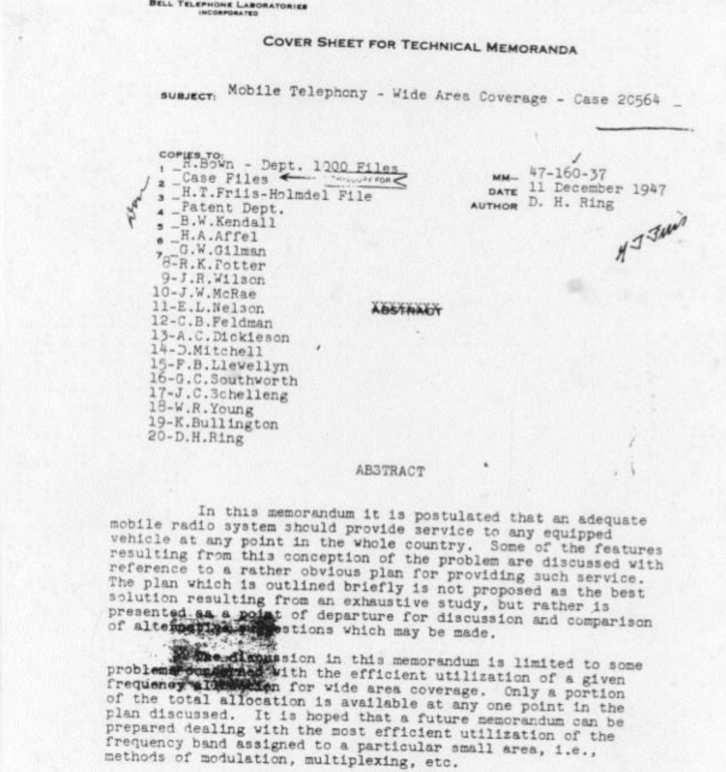
In 1939, William Shockley, a researcher at Bell Labs, wrote in his notebook that he thought it was possible to replace the clunky vacuum tube with semiconductors. After years of work, on December 23, 1947, Shockley, along with fellow Bell Lab researchers John Bardeen and Walter Brattain, demonstrated the transistor, which did the same job as a vacuum tube but needed only a fraction of a tube’s space, power, and cooling requirements – but this is a story far more convoluted and controversial then space allows here.
Suffice it to say that Shockley, who, with Bardeen and Brattain, won a Nobel Prize for his transistor work and founded a company that led to the founding of Intel, was a racist and an advocate of eugenics. In all events, the transistor inaugurated the age of miniaturization and led directly to the development of the microchip found in every device we now use.
In 1954, Texas Instruments produced the first transistors made from silicon, which were more powerful than their germanium predecessors. The first transistor radio, the Regency TR-1 ($49.95, around $576 in today’s money), appeared that same year in a variety of bright, cool colors designed to entice teenagers. “Solid state” soon became the go-to buzzword to denote, promote, and sell the most modern home electronics products.
Japan Reemerges
A year after the Regency TR-1 appeared, a small Japanese company founded by Akio Morita and Masaru Ibuka, Tokyo Telecommunications Engineering (Tokyo Tsushin Kogyo Ltd.), introduced a smaller transistor radio, the TR-55, under the company’s new brand name, Sony. Sony’s transistor radio success inspired other Japanese companies.
By the end of 1957, three dozen Japanese companies had exported more than 100,000 transistor radios to the United States. In 1959, more than six million radios were imported into the U.S., half of Japan’s total output of transistor radios and the country’s fourth largest export. By 1962, transistor radio prices had dropped to around $15 (around $173 today).
Sony was not the only consumer electronics company to rise from the ashes of post-World War II Japan. Before the war, Konosuke Matsushita founded a light socket company that would produce the Panasonic brand, establishing U.S. offices in 1959, and Matsushita would become the world’s largest consumer electronics company for a short while.
In 1961, William Kasuga co-founded Kenwood Electronics, and in 1964 recent college graduate Ken Kai came to the U.S. in 1964 and, partnering with Bernie Mitchell, quickly built Pioneer into a household consumer electronics brand.
Meanwhile, in newly-liberated Korea, Koo In Hwoi started Lak Hai (as in “lucky”) cosmetics company in early 1947. Koo expanded into plastics and, in 1958, founded GoldStar, the first Korean electronics company. GoldStar started manufacturing radios, telephones, appliances, and TV sets for the Korean market under both the GoldStar and Lucky brands, which morphed into LG in 1995.
During the same period, Byung-Chul Lee built his Samsung Trading Company, founded in 1938, into one of Korea’s biggest companies. Initially dealing in textiles, media, and real estate, Lee, one of the country’s most recognized business leaders, eventually started dealing more and more in electronics. In 1969, Lee founded Samsung Electronics.
I’ll have a more expansive look at the growth of Asian companies in the consumer tech space in a few weeks.
A/V Recording
Once you listened to a radio show or watched a TV program, you were one and done. TV shows were captured for either re-running or posterity using a kinescope – a 24 fps film camera synchronized to capture 30 fps video shot directly off a TV screen. As you can imagine and have likely seen, kinescope results were less than ideal, and the film of course first had to be processed, limiting the recording’s immediate use by TV stations. What was needed was a more technologically advanced, more immediate, and higher quality method of capturing audio and video.
Magnetic recording has been a subject of research and development since the late 19th century. Magnetic wire recording was perfected and commercialized by Marvin Camras of the Armour Research Foundation (now the Illinois Institute of Technology) in the 1930s, and wire remained the predominant audio recording technology for the next 15 years, used primarily by the military and the growing federal law enforcement and intelligence gathering agencies.
But wire was unwieldy for editing and produced warbled sound. Between 1932 and 1935, the German industrial giant I.G. Farben AG developed the first magnetic tape recorder, the Magnetophon. The machine was co-developed by Farben and the German General Electric (AEG), and then manufactured by Telefunken. By 1935, unbeknownst to Western engineers, Adolf Hitler and Nazi propagandist minister Joseph Goebbels were using magnetic tape to record and broadcast speeches.
By the end of the war, rumors were pervasive in the American Army Signal Corps that the Germans had developed high-fidelity tape recorders. Army Major John T. Mullin found four Magnetophons in the remains of a Frankfort radio station and sent two of them, along with several reels of red oxide tape made by Farben’s BASF division, to his San Francisco home, where he started to tinker after he returned from his Army service.

On May 16, 1946, Mullin presented his rebuilt Magnetophon tape recorder, the first stereo tape recorder in the free world, at the Institute of Radio Engineers convention. Engineers for Bing Crosby quickly hired Mullin and his machine to tape the notoriously finicky singer’s popular radio show.
Two years later, a tiny company founded by Russian émigré Alexander Poniatoff called Ampex, with Mullin’s help, introduced the company’s Model 200 stereo tape recorder, bringing high-fidelity stereo recording to the consumer market. 3M, under the Scotch brand name, made the first magnetic recording tape, first paper, then acetate-based. Several companies began manufacturing consumer tape recorders by the late 1940s, including Ranger’s Rangertone, Magnecord, and Brush, all of which fueled the development of the home hi-fi craze.
While the public battle over color TV was being waged, a smaller skirmish was being fought in three labs to develop videotape recording: RCA; Bing Crosby’s Labs, headed by Mullin; and, Ampex. On April 14, 1956, a six-man development team at Ampex, headed by Charles Ginsburg and including a young college student named Ray Dolby, shocked the National Association of Broadcasters (NAB) convention in Chicago with the desk-sized Mark IV, the first black & white reel-to-reel videotape recording machine.
RCA traded its color TV technology for Ampex’s video recording technology to produce the first color videotape recorder a few years later. During the next 20 years, several companies, including RCA and Sony, attempted to bring some kind of video recording system into homes, but consumers were resistant to reel-to-reel home video solutions. If video recording was to become a home device, it would have to be simple and convenient – a cassette, for instance.
The Wireless Future

All entertainment technology in the 1950s required cables or wires. But the seeds for our wireless era – cellular phones, GPS, cordless phones, Wi-Fi, Bluetooth, et al – were planted during World War II by the unlikeliest inventor, Hollywood bombshell Hedy Lamarr.
The Austrian-born Lamarr was married to an arms merchant who sold weapons to Nazi Germany and Fascist Italy. Lamarr was naturally curious and, belying her beauty, mechanically inclined, and learned about radio-controlled weapons. After cleverly fleeing both her abusive husband and Austria prior to the war, she became a movie star in America but remained interested in helping her adopted country defeat the Nazis.
Together with avant-garde orchestra leader and composer George Antheil, Lamarr proposed a frequency-hopping radio-controlled torpedo system that would be impervious to Nazi radio jamming. Lamarr and Antheil applied for and received U.S. patent #2,292,387 for their concept, and granted their patent to the Navy, who failed to deploy the technology during the war.
After the war, the Navy handed the patent to defense department contractors, who were ignorant of the patent’s authorship since it bore Lamarr’s official married name, H.K. Markey. In the late 1950s, Sylvania’s Electronic Systems Division devised an electronic version of the frequency-hopping technology and applied it to the problem of securing military communications, later deployed during the 1962 Cuban Missile Crisis.
Of course, Lamarr’s story is far more fascinating than space here allows, and is more extensively and entertainingly told in both Richard Rhodes’s 2011 book, “Hedy’s Folly” and in Alexandra Dean’s 2018 PBS documentary “Bombshell: The Hedy Lamarr Story.” Long story short, Lamarr’s and Antheil’s patent expired in the late 1950s, allowing frequency-hopping, now known as spread spectrum, to be commercialized and enabling all wireless communications technologies that would emerge in the decades to come.
The Microchip
The transistor was a miniaturized miracle, but after attending a transistor seminar at Bell Labs, Texas Instruments researcher Jack Kilby started experimenting with silicon-based components that could make transistors even smaller.
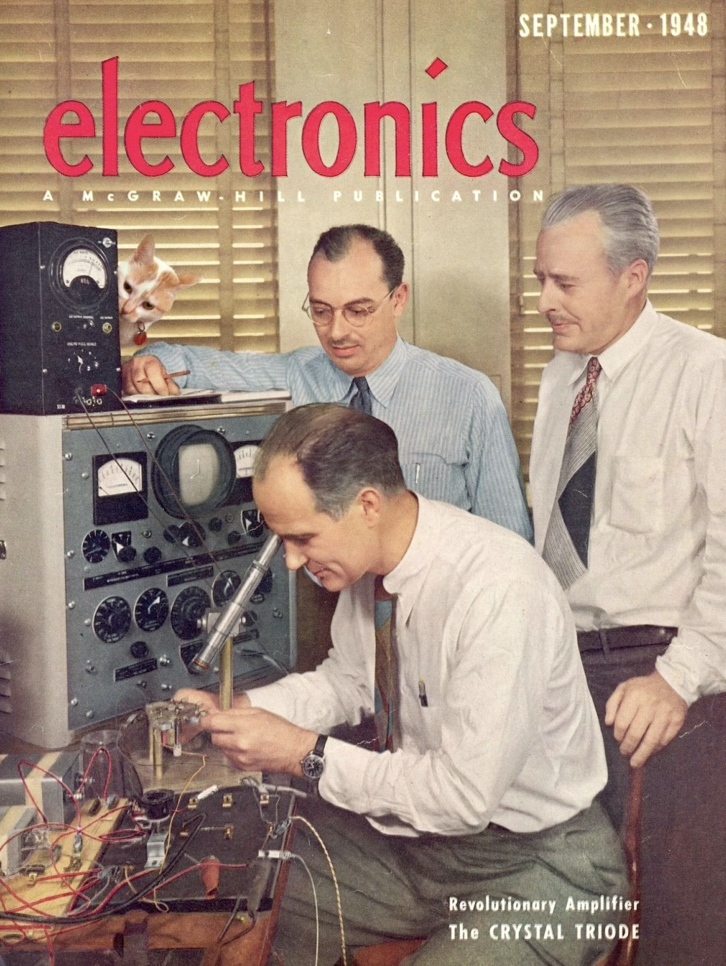
On July 28, 1958, just as the first transistorized TVs were being developed, Kilby struck upon the idea that resistors, capacitors, and transistors all could be mounted on the same chip if made of the same material. Seven months later, Kilby and Texas Instruments filed a patent for the “Miniaturized Electronic Circuit.” The following month, the new microchip, the size of a paper clip, was presented at the Institute of Radio Engineers convention.
Four months later, a protégé and former employee of transistor co-inventor William Shockley, Robert Noyce of the newly formed Fairchild Semiconductors, located in the sleepy valley community of Mountain View near Palo Alto, CA, separately filed for a patent for a similar integrated circuit.
Noyce and Fairchild won a lengthy patent fight with Texas Instruments based on certain interconnection technologies. However the scientific community accepted that both Kilby and Noyce separately but simultaneously had invented the integrated circuit.
Ten years later, Noyce and a number of fellow researchers including Gordon Moore, known collectively as the “Traitorous Eight,” left Fairchild to found their own chip company called Integrated Electronics, later shortened to Intel.
RMA to EIA
TV, transistors, microchips, and audio-video recording were just a smattering of the major postwar consumer technology breakthroughs. The scope of electronics exploded in the decade-plus post-war period, which led RMA toward to a more drastic name, directional change, and organizational structure.
Between 1952 and 1957, home electronics sales declined from 58% to 20% of total U.S. electronics sales, on par with industrial electronics sales, while military electronics sales grew from 20% to more than 52%. As a result, in mid-1957, RETMA changed its name to the more all-encompassing Electronics Industries Association, or EIA, with a second HQ established in LA. The 28 member EIA companies that produced consumer electronics that originally spurred the founding of the RMA was now housed under EIA’s Consumer Products Division and were dwarfed in the EIA hierarchy by the Military Products, Technical Products, Tube and Semiconductor, and Parts divisions.
It would take 10 years for the Consumers Product Division to reassert itself thanks to one visionary. As they once proclaimed in radio and TV land – stay tuned.
Significant Dates:
1946
- The first electronic computer, ENIAC, is demonstrated. (February 15)
- Sony is founded by Masaru Ibuka and Akio Morita. (May 7)
- John Mullin demonstrates improved German-made Magnetophon magnetic tape recorders at the Institute of Radio Engineers (IRE) conference in San Francisco. (May 16)
- The first mobile telephone service begins in St. Louis. (June 17)
1947
- LG Corporation founded in Seoul, South Korea, by Koo In-hwoi. (January 5)
- Edwin Land first demonstrates his instant film camera, the Polaroid. (February 21)
- Computer scientist and Navy rear admiral Grace Murray Hopper coins the term “bug” to describe a computer fault. (September 7)
- Bell Labs researcher Douglas H. Ring writes memo describing cellular telephone system. (December 11)
- William Shockley, John Bardeen, and Walter Brattain invent the transistor at Bell Telephone Laboratories. (December 23)
1948
- The first Citizens Band radios go on sale.
- Cable television begins as Community Access Television in Mahanoy City, PA. (June)
- 33 rpm vinyl LP records, invented by Peter Goldmark, are introduced by Columbia Records. (June 18)
- The prototype Manchester “Baby” becomes the first computer to run a stored program. (June 21)
- In the July issue of The Bell System Technical Journal, Dr. Claude E. Shannon publishes “A Mathematical Theory of Communication,” which lays out the basic concepts of digital communication (July).
1949
- Al Gross invents the wireless telephone pager, first used by the New York Jewish Hospital in 1950.
- The first consumer stereo tape recorders and the first pre-recorded reel-to-reel tapes go on sale.
- First-ever network TV broadcast made on KDKA Pittsburgh, part of the DuMont network. (January 11)
- First commercial 45 rpm record released, “Texarkana Baby” by Eddy Arnold. (March 31)
1950
- RMA changes its name to RTMA (Radio-Television Manufacturers Association)
- CBS conducts first public demonstration of color TV in Washington, D.C. for the FCC. (January 12)
- FCC approves the CBS-developed color TV standard. (October 11)
1951
- The U.S. Supreme Court upholds FCC decision on CBS color TV standard. (May 28)
- UNIVAC first used by U.S. Census Bureau. (June 14)
- CBS broadcasts the first color TV program, the “Premiere” variety show. (June 25)
- President Harry Truman inaugurates the first transcontinental TV broadcast. (September 4)
- RCA demonstrates its all-electronic color TV system. (October 21)
- The first direct-dialed long-distance telephone call is made between the mayors of Englewood, NJ, and Alameda, CA. (November 10)
- John T. Mullin, working for Bing Crosby’s Labs, conducts the first demonstration of video recording on magnetic tape on an altered audio tape recorder. (November 11)
1952
- British radar engineer Geoffrey Dummer introduces the concept of the integrated circuit. (May 7)
- UHF TV broadcasts are authorized. (July 1)
- The first transistorized device, the Sonotone 1010 hearing aid, goes on sale. (December)
1953
- Harman Kardon, which evolves into Harmon International, is founded by Sidney Harman and Bernard Kardon.
- RTMA changes its name to RETMA (Radio-Electronics Television Manufacturers Association). (June 18)
- The first prototype transistorized computer demonstrated at Manchester University. (November 16)
- The FCC accepts RCA-based NTSC-compatible color TV standard. (December 17)
- The first color TVs, a 15-inch Admiral C1617A ($1,175), are sold at retail. (December 30)
1954
- Annual sales of TV sets surpass radios for the first time.
- NBC broadcasts the Tournament of Roses Parade, the first nationwide color broadcast. (January 1)
- Dr. Narinder Kapany describes optical fiber cable in scientific journal Nature; he later coins term “fiber optics,” develops cables, and becomes known as “Father of Fiber Optics.” (January 2)
- Regular color TV broadcasting begins. (January 22)
- RCA begins mass production of CT-100 color TVs, priced at $1,000, the price of a new car. (March 25)
- The first transistor made from silicon is developed. (April 18)
- The first acoustic suspension speaker, the Acoustic Research AR-1, introduced at New York Audio Fair. (October 14)
- The Regency TR-1, the first mass-market transistor “pocket radio,” is introduced at $49.95. (October 18)
1955
- Bell Labs completes TRADIC (TRAnsistorized DIgital Computer), the first all-transistorized computer. (March 14)
- The first consumer microwave oven, a Tappan version of the Raytheon Radarange, is introduced. (October 25)
1956
- The first portable TVs are sold.
- The first transistorized stereo audio receivers are sold.
- Ampex introduces the Mark IV, the first commercial videotape recorder, at the NAB show in Chicago. (April 14)
- The first transatlantic telephone cable becomes operational. (September 25)
- The computer hard drive, IBM 305 RAMAC (Random Access Method of Accounting and Control), is announced. (September 14)
1957
- The RETMA (Radio Electronics Television Manufacturers Association) changes its name to the EIA (Electronic Industries Association).
- Fairchild Semiconductor, a pioneering chip designer and maker, founded. (October 1)
1958
- Hi-Fi stereo components for the home become a mainstream CE category at retail for the first time.
- AT&T introduces the first commercial “modem,” the Bell 101, for the SAGE military radar computer.
- The first consumer stereo headphones, Koss SP/3, become available.
- The first stereo record, “Johnny Puleo and His Harmonica Gang,” on the Audio Fidelity label, is released. (March)
- The FCC creates the Citizens Band (CB) radio service. (September 11)
- Jack Kilby gives first demonstration of the integrated circuit. (September 12)
- Brookhaven National Labs researcher Willy Higinbotham publicly demonstrates a two-player tennis game on an oscilloscope, the first videogame. (October 18)
1959
- Jack Kilby of Texas Instruments files a patent for the integrated circuit; considered a co-inventor with Fairchild’s Robert Noyce. (May 6)
- The Philco Safari, first all-transistorized battery-powered portable TV, is announced. (June 14)
- Robert Noyce of Fairchild Semiconductors files patent for the integrated circuit; considered a co-inventor with TI’s Jack Kilby. (July 30)
- “Bonanza,” the first television show produced in color, premiers. (September 12)
- The Xerox 914, the first plain-paper Xerox copier, is introduced. (September 16)
- Union Carbide engineer Lew Urry invents the consumer alkaline battery. (October 9)
1960
- The first telephone-answering device, the Ansafone from Phonetel, goes on sale.
- First imported TVs go on sale in the U.S.
- The first transistorized TV, the 8-inch Sony TV8-301, goes on sale.
- Dr. Theodore Maiman builds the first working laser. (May 16)
- Echo, the first communications satellite, launches. (August 12)




